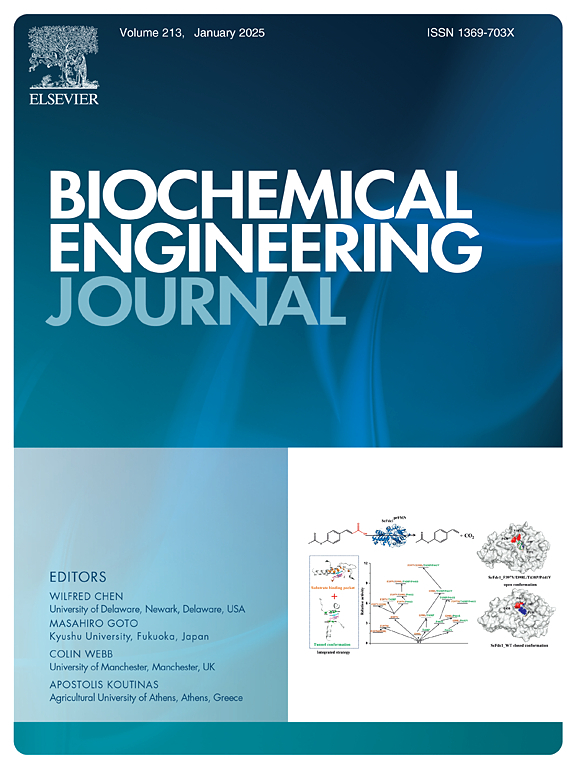Removal of lysozyme as protein waste using weak ion exchange nanofiber membrane in a batch system: Linear and nonlinear model analysis
IF 3.7
3区 生物学
Q2 BIOTECHNOLOGY & APPLIED MICROBIOLOGY
引用次数: 0
Abstract
This study investigates the removal of lysozyme, a common waste protein, using weak ion-exchange nanofiber membranes (P-COOH) to address challenges in protein waste management and wastewater treatment. Protein waste, prevalent in industrial and biological processes, contributes to environmental pollution and increases treatment complexity if not effectively managed. Conventional methods often face limitations in selectivity and efficiency, highlighting the need for innovative solutions. The P-COOH nanofiber membrane, with its high surface area and tailored functional groups, was engineered to optimize protein removal. The removal process was analyzed in a batch system at an optimal pH of 7. Various kinetic models, such as pseudo-first-order, pseudo-second-order, Avrami, and intra-particle diffusion, were applied to elucidate rate-controlling steps. In contrast, isotherm models, including Langmuir, Freundlich, and Temkin, characterized the equilibrium of the removal process. Complete elution of removed lysozyme was achieved using a 0.3 M NaCl solution, yielding an equilibrium binding capacity of 315.24 mg/g on the nanofiber membranes. These findings indicate that the Avrami nonlinear model best describes lysozyme removal's complex, multi-step kinetics. In contrast, the Langmuir linear model accurately fits the equilibrium data, suggesting monolayer removal on a homogeneous surface. The successful reusability of the membranes underscores their potential for sustainable lysozyme removal from wastewater, offering a viable solution for improved waste management in industrial applications.
在批处理系统中使用弱离子交换纳米纤维膜去除作为蛋白质废物的溶菌酶:线性和非线性模型分析
本研究调查了使用弱离子交换纳米纤维膜(P-COOH)去除溶菌酶(一种常见的废弃蛋白质)的情况,以应对蛋白质废弃物管理和废水处理方面的挑战。蛋白质废物普遍存在于工业和生物过程中,如果得不到有效管理,会造成环境污染并增加处理的复杂性。传统方法往往在选择性和效率方面受到限制,因此需要创新的解决方案。P-COOH 纳米纤维膜具有高表面积和定制功能基团,可优化蛋白质去除效果。在最佳 pH 值为 7 的批处理系统中对去除过程进行了分析。各种动力学模型,如伪一阶、伪二阶、Avrami 和颗粒内扩散模型,被用于阐明速率控制步骤。相反,等温线模型,包括 Langmuir、Freundlich 和 Temkin,则描述了去除过程的平衡状态。使用 0.3 M NaCl 溶液可实现溶菌酶的完全洗脱,纳米纤维膜上的平衡结合能力为 315.24 mg/g。这些研究结果表明,阿夫拉米非线性模型最能描述溶菌酶去除的复杂、多步骤动力学。与此相反,Langmuir 线性模型精确地拟合了平衡数据,表明在均匀表面上的单层去除。膜的成功重复使用强调了其可持续去除废水中溶菌酶的潜力,为改善工业应用中的废物管理提供了可行的解决方案。
本文章由计算机程序翻译,如有差异,请以英文原文为准。
求助全文
约1分钟内获得全文
求助全文
来源期刊

Biochemical Engineering Journal
工程技术-工程:化工
CiteScore
7.10
自引率
5.10%
发文量
380
审稿时长
34 days
期刊介绍:
The Biochemical Engineering Journal aims to promote progress in the crucial chemical engineering aspects of the development of biological processes associated with everything from raw materials preparation to product recovery relevant to industries as diverse as medical/healthcare, industrial biotechnology, and environmental biotechnology.
The Journal welcomes full length original research papers, short communications, and review papers* in the following research fields:
Biocatalysis (enzyme or microbial) and biotransformations, including immobilized biocatalyst preparation and kinetics
Biosensors and Biodevices including biofabrication and novel fuel cell development
Bioseparations including scale-up and protein refolding/renaturation
Environmental Bioengineering including bioconversion, bioremediation, and microbial fuel cells
Bioreactor Systems including characterization, optimization and scale-up
Bioresources and Biorefinery Engineering including biomass conversion, biofuels, bioenergy, and optimization
Industrial Biotechnology including specialty chemicals, platform chemicals and neutraceuticals
Biomaterials and Tissue Engineering including bioartificial organs, cell encapsulation, and controlled release
Cell Culture Engineering (plant, animal or insect cells) including viral vectors, monoclonal antibodies, recombinant proteins, vaccines, and secondary metabolites
Cell Therapies and Stem Cells including pluripotent, mesenchymal and hematopoietic stem cells; immunotherapies; tissue-specific differentiation; and cryopreservation
Metabolic Engineering, Systems and Synthetic Biology including OMICS, bioinformatics, in silico biology, and metabolic flux analysis
Protein Engineering including enzyme engineering and directed evolution.
 求助内容:
求助内容: 应助结果提醒方式:
应助结果提醒方式:


